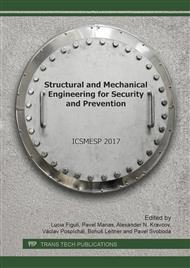p.139
p.147
p.153
p.159
p.170
p.181
p.190
p.198
p.202
Pushover Analysis Based on Equivalent Diagonal Springs for the Assessment of the Seismic Safety of Post-and-Beam Timber Buildings Braced with Nailed Shear Walls
Abstract:
A method for a simplified modeling of post-and-beam timber buildings braced with nailed shear walls, useful for seismic design purposes, is presented and discussed in the paper. This strategy is based on the schematization of the vertical diaphragms through equivalent diagonal springs with elastic-plastic behavior and allows the assessment of the resisting ground acceleration by performing nonlinear static analysis; the Capacity Spectrum method based on equivalent viscous damping was applied. This nonlinear procedure constitutes a reliable and simple alternative to the linear static analysis using the behavior factor q. The procedures to determine the characteristics of the equivalent elements (stiffness and load-carrying capacity) are based on analytical evaluations, starting from the actual characteristic of shear walls. A comparison between the results of numerical simulation based of more refined and complex models, previously presented by the authors, and this time-reducing, simplified analysis proved the good reliability of the method.
Info:
Periodical:
Pages:
170-180
Citation:
Online since:
September 2017
Authors:
Price:
Сopyright:
© 2017 Trans Tech Publications Ltd. All Rights Reserved
Share:
Citation:


